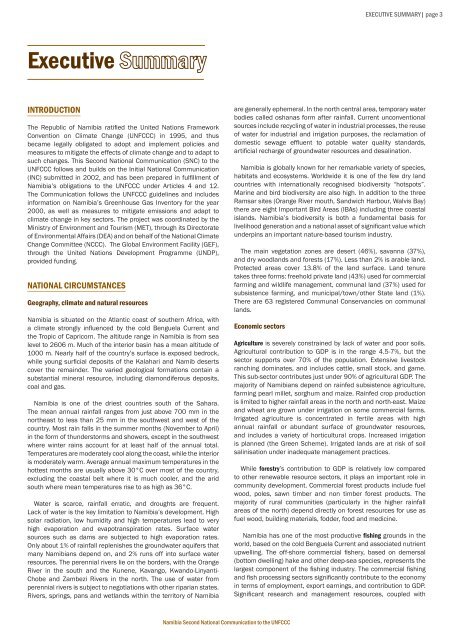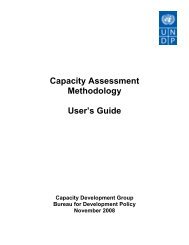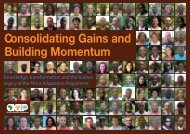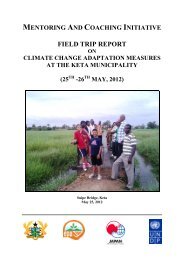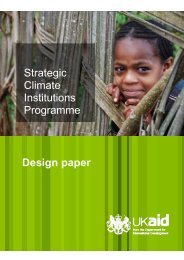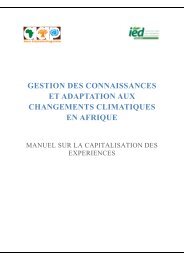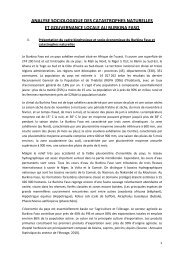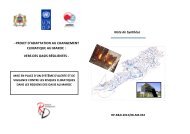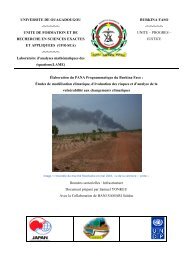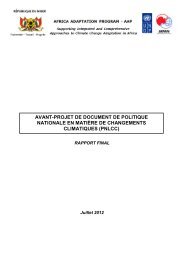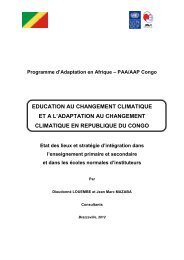Namibia Second National Communication to UNFCCC 2011.pdf
Namibia Second National Communication to UNFCCC 2011.pdf
Namibia Second National Communication to UNFCCC 2011.pdf
Create successful ePaper yourself
Turn your PDF publications into a flip-book with our unique Google optimized e-Paper software.
EXECUTIVE SUMMARY| page 3ExecutiveINTRODUCTIONThe Republic of <strong>Namibia</strong> ratified the United Nations FrameworkConvention on Climate Change (<strong>UNFCCC</strong>) in 1995, and thusbecame legally obligated <strong>to</strong> adopt and implement policies andmeasures <strong>to</strong> mitigate the effects of climate change and <strong>to</strong> adapt <strong>to</strong>such changes. This <strong>Second</strong> <strong>National</strong> <strong>Communication</strong> (SNC) <strong>to</strong> the<strong>UNFCCC</strong> follows and builds on the Initial <strong>National</strong> <strong>Communication</strong>(INC) submitted in 2002, and has been prepared in fulfillment of<strong>Namibia</strong>’s obligations <strong>to</strong> the <strong>UNFCCC</strong> under Articles 4 and 12.The <strong>Communication</strong> follows the <strong>UNFCCC</strong> guidelines and includesinformation on <strong>Namibia</strong>’s Greenhouse Gas Inven<strong>to</strong>ry for the year2000, as well as measures <strong>to</strong> mitigate emissions and adapt <strong>to</strong>climate change in key sec<strong>to</strong>rs. The project was coordinated by theMinistry of Environment and Tourism (MET), through its Direc<strong>to</strong>rateof Environmental Affairs (DEA) and on behalf of the <strong>National</strong> ClimateChange Committee (NCCC). The Global Environment Facility (GEF),through the United Nations Development Programme (UNDP),provided funding.NATIONAL CIRCUMSTANCESGeography, climate and natural resources<strong>Namibia</strong> is situated on the Atlantic coast of southern Africa, witha climate strongly influenced by the cold Benguela Current andthe Tropic of Capricorn. The altitude range in <strong>Namibia</strong> is from sealevel <strong>to</strong> 2606 m. Much of the interior basin has a mean altitude of1000 m. Nearly half of the country’s surface is exposed bedrock,while young surficial deposits of the Kalahari and Namib desertscover the remainder. The varied geological formations contain asubstantial mineral resource, including diamondiferous deposits,coal and gas.<strong>Namibia</strong> is one of the driest countries south of the Sahara.The mean annual rainfall ranges from just above 700 mm in thenortheast <strong>to</strong> less than 25 mm in the southwest and west of thecountry. Most rain falls in the summer months (November <strong>to</strong> April)in the form of thunders<strong>to</strong>rms and showers, except in the southwestwhere winter rains account for at least half of the annual <strong>to</strong>tal.Temperatures are moderately cool along the coast, while the interioris moderately warm. Average annual maximum temperatures in thehottest months are usually above 30°C over most of the country,excluding the coastal belt where it is much cooler, and the aridsouth where mean temperatures rise <strong>to</strong> as high as 36°C.Water is scarce, rainfall erratic, and droughts are frequent.Lack of water is the key limitation <strong>to</strong> <strong>Namibia</strong>’s development. Highsolar radiation, low humidity and high temperatures lead <strong>to</strong> veryhigh evaporation and evapotranspiration rates. Surface watersources such as dams are subjected <strong>to</strong> high evaporation rates.Only about 1% of rainfall replenishes the groundwater aquifers thatmany <strong>Namibia</strong>ns depend on, and 2% runs off in<strong>to</strong> surface waterresources. The perennial rivers lie on the borders, with the OrangeRiver in the south and the Kunene, Kavango, Kwando-Linyanti-Chobe and Zambezi Rivers in the north. The use of water fromperennial rivers is subject <strong>to</strong> negotiations with other riparian states.Rivers, springs, pans and wetlands within the terri<strong>to</strong>ry of <strong>Namibia</strong>are generally ephemeral. In the north central area, temporary waterbodies called oshanas form after rainfall. Current unconventionalsources include recycling of water in industrial processes, the reuseof water for industrial and irrigation purposes, the reclamation ofdomestic sewage effluent <strong>to</strong> potable water quality standards,artificial recharge of groundwater resources and desalination.<strong>Namibia</strong> is globally known for her remarkable variety of species,habitats and ecosystems. Worldwide it is one of the few dry landcountries with internationally recognised biodiversity “hotspots”.Marine and bird biodiversity are also high. In addition <strong>to</strong> the threeRamsar sites (Orange River mouth, Sandwich Harbour, Walvis Bay)there are eight Important Bird Areas (IBAs) including three coastalislands. <strong>Namibia</strong>’s biodiversity is both a fundamental basis forlivelihood generation and a national asset of significant value whichunderpins an important nature-based <strong>to</strong>urism industry.The main vegetation zones are desert (46%), savanna (37%),and dry woodlands and forests (17%). Less than 2% is arable land.Protected areas cover 13.8% of the land surface. Land tenuretakes three forms: freehold private land (43%) used for commercialfarming and wildlife management, communal land (37%) used forsubsistence farming, and municipal/<strong>to</strong>wn/other State land (1%).There are 63 registered Communal Conservancies on communallands.Economic sec<strong>to</strong>rsAgriculture is severely constrained by lack of water and poor soils.Agricultural contribution <strong>to</strong> GDP is in the range 4.5-7%, but thesec<strong>to</strong>r supports over 70% of the population. Extensive lives<strong>to</strong>ckranching dominates, and includes cattle, small s<strong>to</strong>ck, and game.This sub-sec<strong>to</strong>r contributes just under 90% of agricultural GDP. Themajority of <strong>Namibia</strong>ns depend on rainfed subsistence agriculture,farming pearl millet, sorghum and maize. Rainfed crop productionis limited <strong>to</strong> higher rainfall areas in the north and north-east. Maizeand wheat are grown under irrigation on some commercial farms.Irrigated agriculture is concentrated in fertile areas with highannual rainfall or abundant surface of groundwater resources,and includes a variety of horticultural crops. Increased irrigationis planned (the Green Scheme). Irrigated lands are at risk of soilsalinisation under inadequate management practices.While forestry’s contribution <strong>to</strong> GDP is relatively low compared<strong>to</strong> other renewable resource sec<strong>to</strong>rs, it plays an important role incommunity development. Commercial forest products include fuelwood, poles, sawn timber and non timber forest products. Themajority of rural communities (particularly in the higher rainfallareas of the north) depend directly on forest resources for use asfuel wood, building materials, fodder, food and medicine.<strong>Namibia</strong> has one of the most productive fishing grounds in theworld, based on the cold Benguela Current and associated nutrientupwelling. The off-shore commercial fishery, based on demersal(bot<strong>to</strong>m dwelling) hake and other deep-sea species, represents thelargest component of the fishing industry. The commercial fishingand fish processing sec<strong>to</strong>rs significantly contribute <strong>to</strong> the economyin terms of employment, export earnings, and contribution <strong>to</strong> GDP.Significant research and management resources, coupled with<strong>Namibia</strong> <strong>Second</strong> <strong>National</strong> <strong>Communication</strong> <strong>to</strong> the <strong>UNFCCC</strong>


